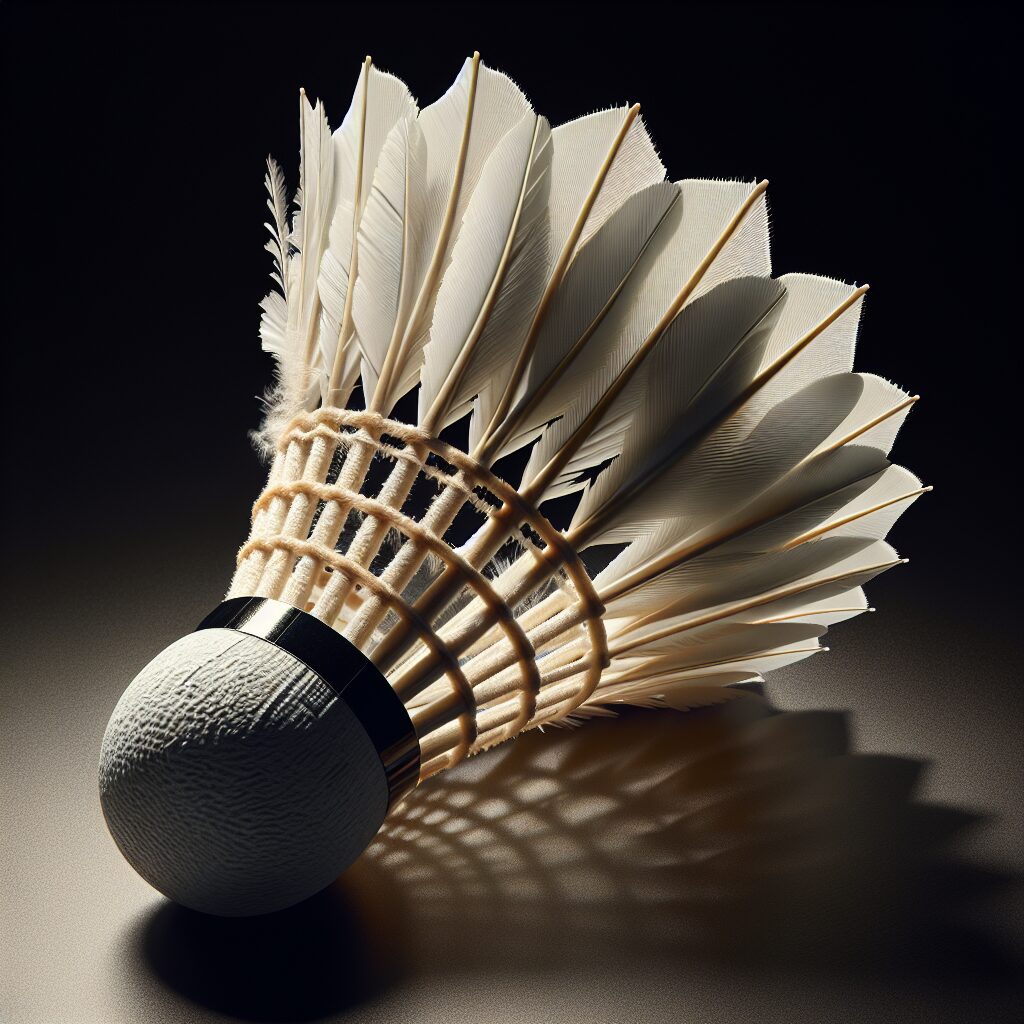Understanding the Materials of Badminton Shuttlecocks
In the world of badminton, shuttlecocks play a crucial role in determining the speed, flight, and overall performance of the game. But have you ever wondered what goes into making these small, feathered projectiles? The material used in making shuttlecocks is a key factor that greatly influences their performance on the court. In this article, we will delve into the materials commonly used in crafting badminton shuttlecocks and explore their unique features and impacts. By understanding the materials of badminton shuttlecocks, players and enthusiasts alike can gain valuable insights into the game and make informed choices when it comes to selecting the perfect shuttlecock for their matches.
One of the most intriguing aspects of badminton shuttlecocks is the use of feathers as the primary material. Traditionally, shuttlecocks were made using feathers from duck or goose wings. These feathers possess a remarkable combination of qualities that make them ideal for the sport. The natural flexibility and aerodynamic properties of feathers allow the shuttlecock to travel swiftly and accurately through the air. Additionally, the unique structure of feathers, with their small barbs and soft quill, enhances the shuttlecock’s stability and ensures consistent flight during intense rallies. However, with the advancement of technology, synthetic materials such as nylon have also made their way into shuttlecock production, offering an alternative to traditional feathered designs. This development has sparked a debate among players over the benefits and drawbacks of using synthetic shuttlecocks.
Now that we have gained insights into the materials of badminton shuttlecocks, let’s delve into the key takeaways. In the following sections, we will examine the impact of feathered shuttlecocks versus synthetic ones on gameplay, explore the factors that contribute to shuttlecock durability, and discuss the significance of selecting the right shuttlecock for different playing conditions. By understanding these key aspects, badminton players and enthusiasts can elevate their game and make more informed choices when it comes to the materials used in the construction of shuttlecocks. So, let’s dive deeper into the world of badminton shuttlecock materials and unravel the secrets behind their performance on the court.
Key Takeaways
1. Different materials are used to manufacture badminton shuttlecocks, with the two primary options being feathers and synthetic materials.
2. Feather shuttlecocks are generally preferred by professional players due to their superior flight characteristics and better overall performance.
3. Synthetic shuttlecocks, on the other hand, are more durable and cost-effective, making them a popular choice for recreational players and training purposes.
4. The different feather types used in shuttlecocks have distinct characteristics that greatly impact their flight stability and durability.
5. Manufacturers are constantly researching and developing new materials and manufacturing techniques to enhance shuttlecock performance and durability, aiming to strike a balance between performance and cost-effectiveness.
What are the materials used in Badminton Shuttlecocks?
Feather Shuttlecocks
Feather shuttlecocks are the traditional and most commonly used type of shuttlecocks in badminton. These shuttlecocks are made using the feathers from ducks or geese. The feathers are carefully selected and processed to ensure optimal flight and durability. Feather shuttlecocks offer excellent performance and are preferred by professional players due to their consistent flight characteristics and natural feel.
Nylon Shuttlecocks
In contrast to feather shuttlecocks, nylon shuttlecocks are made using synthetic materials such as nylon. These shuttlecocks are typically more affordable and long-lasting compared to feather shuttlecocks. They are ideal for recreational players and beginners who are looking for a durable option that doesn’t require frequent replacement. Nylon shuttlecocks may not provide the same level of performance and feel as feather shuttlecocks but offer decent flight stability and durability.
Hybrid Shuttlecocks
Hybrid shuttlecocks combine the features of feather and nylon shuttlecocks. They feature a synthetic skirt, usually made of nylon, combined with real feathers attached to the base. Hybrid shuttlecocks aim to bridge the gap between feather and nylon shuttlecocks, offering improved durability and flight performance compared to nylon shuttlecocks while maintaining some of the natural feel and characteristics of feather shuttlecocks.
Factors Affecting Material Selection
When selecting the material for a shuttlecock, several factors come into play:
Player Level
The skill level of the player is an important factor to consider. Professional and advanced players often opt for feather shuttlecocks as they provide the most authentic flight and feel. On the other hand, beginners and recreational players may find nylon shuttlecocks more suitable due to their affordability and durability.
Playing Environment
The playing environment also plays a role in material selection. Feather shuttlecocks are highly sensitive to air resistance and temperature, making them more suitable for indoor play. Nylon shuttlecocks, on the other hand, can withstand outdoor conditions and variations in temperature better and are commonly used for outdoor games.
Cost
The cost is another crucial factor when choosing shuttlecock materials. Feather shuttlecocks are more expensive due to the use of real feathers and the intricate production process involved. Nylon shuttlecocks offer a more budget-friendly option for players who don’t want to invest in frequent shuttlecock replacements.
Personal Preference
Ultimately, the personal preference of the player also matters. Some players may prefer the natural feel and performance of feather shuttlecocks, while others may prioritize durability and cost-effectiveness and opt for nylon shuttlecocks.
Conclusion
Understanding the materials used in badminton shuttlecocks is crucial for players when selecting the right shuttlecock for their needs. Feather shuttlecocks offer superior performance and feel, while nylon shuttlecocks provide durability and affordability. Hybrid shuttlecocks aim to combine the best of both worlds. Factors such as player level, playing environment, cost, and personal preference should be considered when making a choice.
- How does the player’s skill level affect the choice of shuttlecock material?
- What is the impact of the playing environment on shuttlecock material selection?
- Why do nylon shuttlecocks offer a more budget-friendly option?
- What factors should be considered when choosing shuttlecock material?
Frequently Asked Questions
1. What materials are commonly used to make badminton shuttlecocks?
Badminton shuttlecocks are typically made using either feathers or synthetic materials. Feather shuttlecocks are made from the feathers of ducks or geese, while synthetic shuttlecocks are made from nylon or other man-made materials.
2. Are feather shuttlecocks better than synthetic ones?
Feather shuttlecocks are often considered superior in terms of flight and feel. They offer better control and are preferred by professional players for their performance. However, synthetic shuttlecocks are more durable and cost-effective, making them a popular choice for casual or recreational players.
3. How are feather shuttlecocks made?
Feather shuttlecocks are made by selecting high-quality feathers, typically from the left wing of a bird, which are then trimmed and processed. The feathers are inserted into a cork or rubber base, and the shuttlecock is finally given its distinctive shape through careful manufacturing processes.
4. Are there any specific feather types commonly used in shuttlecocks?
Badminton shuttlecocks are primarily made using feathers from ducks or geese. The specific types of feathers used can vary, with feathers from the left wing of a goose being a popular choice due to their excellent flight characteristics.
5. How are synthetic shuttlecocks made?
Synthetic shuttlecocks are made using man-made materials such as nylon. The materials are carefully crafted to mimic the flight characteristics of feather shuttlecocks. Synthetic shuttlecocks are created through injection molding, where the components are shaped and assembled into the final shuttlecock form.
6. Are there any advantages of using synthetic shuttlecocks?
One of the main advantages of using synthetic shuttlecocks is their durability. They can withstand more intense gameplay and last longer compared to feather shuttlecocks. Additionally, synthetic shuttlecocks are not affected by temperature or humidity changes, making them a reliable choice in various playing conditions.
7. Which type of shuttlecock should beginners use?
For beginners, synthetic shuttlecocks are a recommended choice. They are more forgiving and easier to control, allowing beginners to focus on developing their technique. Synthetic shuttlecocks also provide a cost-effective option for beginners who may not want to invest in feather shuttlecocks initially.
8. Can I use feather and synthetic shuttlecocks together?
Yes, it is possible to use both feather and synthetic shuttlecocks together during practice sessions or casual games. This allows players to experience the different flight characteristics and adjust their gameplay accordingly. However, for official or competitive matches, it is important to use shuttlecocks of the same type.
9. How can I extend the lifespan of my shuttlecocks?
To prolong the lifespan of shuttlecocks, it is recommended to store them in a cool and dry place, away from direct sunlight or extreme temperatures. Additionally, avoiding excessive force during gameplay and regularly inspecting and replacing damaged shuttlecocks can help extend their usage.
10. Can shuttlecock materials affect gameplay?
Absolutely! The choice of shuttlecock materials can significantly impact gameplay. Feather shuttlecocks offer better flight and feel, making them ideal for more skilled players. On the other hand, synthetic shuttlecocks are generally more suited for beginners or casual players who prioritize durability and cost-effectiveness.
Final Thoughts
Understanding the materials used in badminton shuttlecocks is essential for players of all levels. Whether you prefer the traditional feel and performance of feather shuttlecocks or opt for the longevity and affordability of synthetic ones, choosing the right shuttlecock can greatly enhance your playing experience. Experimentation and finding what works best for your style and skill level is key. So, go ahead, grab your racket, and start exploring the wide world of badminton shuttlecocks!
In conclusion, while the materials used in shuttlecocks may vary, what matters most is finding the shuttlecock that suits your playing needs and preferences. Whether you are a recreational player seeking durability or a professional player aiming for precision and control, there is a perfect shuttlecock out there for you. Remember to consider factors such as feather or synthetic, flight characteristics, and price when making your choice. Now, armed with a better understanding of shuttlecock materials, you can make an informed decision and enjoy the exhilarating game of badminton to its fullest.




